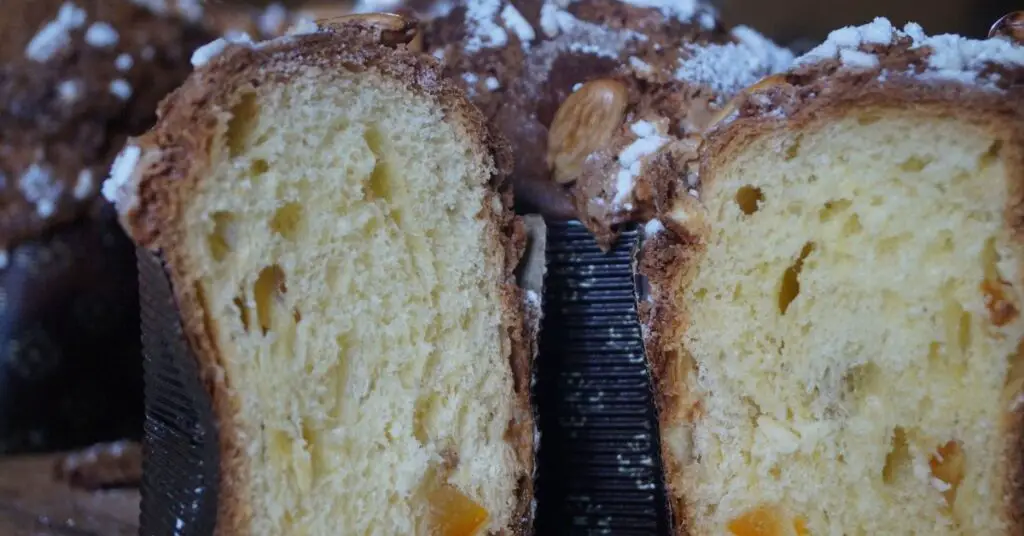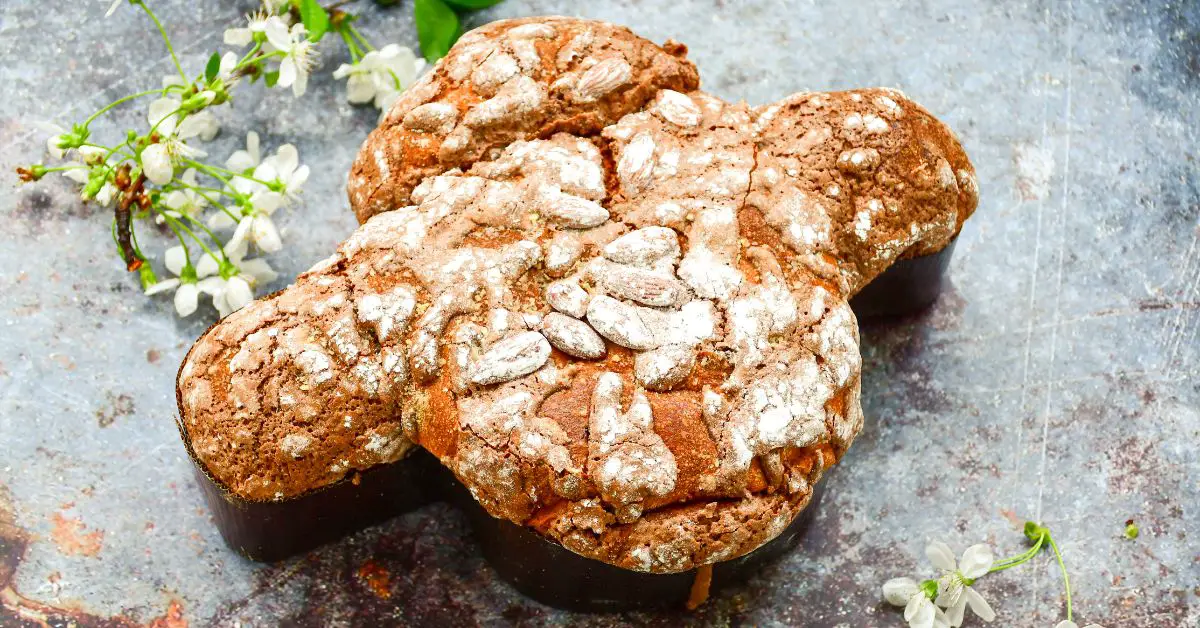A cake shaped like a dove to cut and bite into on Easter day. What? These Italians are so strange!
I know, said so, it can have a bad effect but I assure you that there is nothing macabre or splatter in this tradition: far from it.
This large and voluminous Easter sweet bread symbolizes the hope of salvation referring to the Genesis episode in which a dove brings an olive branch to Noah who, thanks to that gesture, understands that the Universal Flood has stopped and that the water has withdrawn.
From here, other rituals also come to life that are now integral part of the Italian identity: indeed, at Easter there is the custom of exchanging olive branches in order to wish each other peace and serenity. A reconciliation with others and the world after the terrible events that occurred (for Jesus, the crucifixion and death; for Noah, the commitment to make humanity and all creation survive the Universal Flood).
So, the colomba is the perfect dessert to finish the Easter lunch according to the Roman Catholic tradition since it represents a white dove, a symbol of the Holy Spirit and more generally the emblem of hope and salvation.

Now you can sit down and relax; I will tell you the story of this bizarre dessert. However, you must know that the legend combines with history and it becomes difficult to distinguish the two souls of the matter, but I anticipate that marketing (so much for religiosity) has played a fundamental role in the success of this tasty dessert.
Origin of Easter Colomba: history, legend and marketing
Thanks to its history, Italy has been a crossroads of people who have inhabited, invaded, conquered, torn it apart and brought it back to life, by merging and stratifying several cultures in the same places.
Around 570 AD, it was the Longobards who occupied the scene: specifically, after three years of siege, King Alboino managed to make his triumphal entry into Pavia, which succumbed in the days before Easter 572. Legend says that the first gift of people for the sovereign was just a sweet bread in the shape of a dove, which symbolized a message of peace and hospitality.
However, other sources attribute the invention to San Colombano, an Irish missionary monk and evangelist, who lived in the same years and he was invited by the sovereigns to a sumptuous Longobard lunch.
In order not to transgress the abstention from meat desired by Lent, it seems that the monk looked for a middle way to carry out his vow without disrespecting the queen: he offered to bless the courses and, after laying on his hands, realized that everything turned into white doves of bread!
Going forward in time and more tangible witness, the invention of the Easter colomba and its commercialization would be an ingenious marketing operation that dates back to the 1930s; therefore, less than a century ago: the idea came from the advertising director Dino Villani, who had been able to create a long-life easter dessert to be brought to the tables of all Italians with minimal economic effort.
In practice, he recycled the dough and the machinery of panettone (typical dome-shaped Christmas cakes) that are produced for Christmas, with the aim of creating a cake that had a different but equally distinctive shape and which would become a symbol of Easter, exactly as was the Panettone for Christmas holidays: the only variant considered was the addition of an almond frosting on the surface.
Dino Villani’s idea was nothing short of brilliant and, basically, he invented the Easter Panettone; so colomba became the Easter dessert marketed throughout Italy.
The customer’s confectionery company from Milan, Motta, was overwhelmed by the sales success of this sweet and, since then, our country has continued to renew this tradition. Nowadays Motta has a lot of competition as there are many brands that distribute packaged Easter cakes, after which I will recommend the one that, in my opinion, is currently the best.
Easter Colomba = Industrial and packaged cake [but Italians love it anyway]
If you are wondering if those Nazi-cooking Italians prefer to prepare the Easter colomba at home, the answer is no.
Weird, right?
Colomba, panettone, pandoro are rarely cooked in the family and they are almost always bought packaged in supermarkets, but there are those who prefer the artisanal variant to the industrial one. And the reasons are many.
Let’s start from the fact that there is a 2005 directive which establishes that the Easter colomba, to be called in this way, must satisfy specific features:
- the only source of fat contained must be butter;
- the icing can change depending on the variants, but it must be made in a very specific way;
- cooking must respect the established times.
All gastronomic ideas that do not follow this specification can only be considered under the generic name of “Easter dessert”.
However, what is the difference between an artisanal colomba that can be bought in an Italian pastry shop and an industrial one that can be bought in a supermarket where they are usually packaged in colored cardboard boxes?
- First of all, the freshness and, trust me, you can feel it at the first bite: industrial products are always the offspring of an assembly line that starts a long time before being put on the market and, therefore, they cannot help but contain preservatives that ensure them a very “long life”. On the other hand, the artisanal ones are kept less long, but are surely more genuine and incorporate that sensation of “just out of the oven” which is incomparable on the palate.
- Another issue: leavening. The industrial colomba can also “swell” with a chemical yeast, while the artisan one is left to leaven for 24 hours exclusively with sourdough, becoming softer, deeply alveolate and, above all, more easily digestible.
- Actually, the whole sector of raw materials differs a lot, because an artisanal colomba is usually mixed with fresh, high-quality products which, obviously, are light years away from those designed for the assembly line.
In short, although there are excellent industrial colomba, none can really give a hard time to an artisanal one, which also presents itself with more style on the table thanks to a uniform frosting, with attention to the smallest details, without cracks or flaws.

So, why do the vast majority of us Italians, when Easter approaches, never fail to buy a packaged colomba at the supermarket instead of choosing the artisanal one?
The answer is simple and I explained it in part above, since colomba is a dessert born from a marketing operation by Motta (a very important Italian confectionery group), by its own “tradition” it was born precisely as a large-scale retail dessert which later it was reproduced by pastry shops and ovens in the artisan variant.
That is why only in this case, Italians prefer the packaged product to the artisanal one, by habit and tradition the colomba is really an industrial product, not an artisanal one.
My advice is: definitely try the packaged colomba but, if you get the chance, try an artisanal colomba, you will understand the differences right now.
But don’t be fooled by the Colomba; in Italy, every region has a deep tradition of homemade sweets, mostly prepared by small pastry shops and home bakeries. Read here to see the traditional Tuscan Easter desserts.
The best supermarket Colomba in Italy
After these clarifications, we have to say that, for all these reasons, the price of an artisanal colomba can also double and triple that of an industrial variant. In addition, the ovens involved in their production work only by reservation and you need to anticipate a lot to have the dessert at home at the right time.
Also for this reason many Italians prefer something cheaper and immediately available simply by crossing the threshold of the supermarket.
If you were to find yourself in Italy during the Easter holidays and you would like to try this dessert; therefore, I suggest you find the Maina colomba on the shelves of the shops: for around € 6.50, you can take home the work of a specialized Turin confectionery company in the production of panettone, pandoro, Easter colombe and eggs; in the sense that it only produces these desserts and that it is! Definitely the best choice you can make.
From about mid-March you will be able to find the first Easter cakes in supermarkets, but pay attention, because in the same period you will not be able to try pandoro and panettone to make the comparison, because their availability is exclusive to Christmas…unless you want to extend the your stay here and enjoy all the Italian confectionery rainbow dedicated to the holidays!







